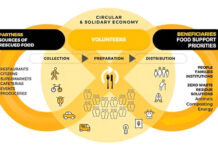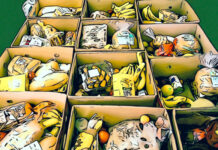Sustainable Italian rice. A virtuous example in the Vercelli area, #RiceInFlower, shows us the values that should be paid attention to when choosing the cereal base for many dishes.
Rice and consumption, a superficial relationship
It is rare for even the most attentive Consumer to consider the sustainability of a risotto. Every once in a while a news story appears, such as the legend of plastic Chinese rice and the various underwhelming alerts about physical (heavy metal) or chemical (pesticide residues above permissible limits) contamination. Beyond these color notes, the choice of rice today is based on two criteria:
– the mark. Industry Branding (IDM), Distributor Branding (MDD), soon to be Consumer Branding (MDC). The consumer relies first and foremost on the brand, with a kind of blank proxy that is often undeserved. Because the banner of historical brands often implies the total absence of values and the only certainty is that of product homogeneity. Triviality and standardization of medium to low quality, as already seen in the extra virgin olive oil sector,
– the
cultivar
, which detects according to the recipe
for which the cereal is intended. As many as 120 different rice are grown in Italy, the rice field of Europe. FromArborio to Carnaroli, Vialone Nano, Roma and Baldo for risottos. Biodiversity of the rest escapes supply mass market, tended to be flattened by period fashions. Pilaf has for years given way to Asian basmati, which maintains its position. But it is Venus in the limelight, with its Po Valley-esque charm And nutraceutical inspiration.
The Italian-ness of rice has never determined the choices of consumers, who are still content with the Italian semblance of the brand. Without even checking whether the Scotti or Gallo rice on duty was grown in Italy or in who knows which Asian country, Under what environmental and working conditions. Piedmont and Lombardy rice growers, after all, have never protested with the effectiveness of Sardinian shepherds
and Apulian olive growers
.
Rice farming in Italy is in danger of disappearing when European tariffs come down in three years, but the supply chain is once again left to its own devices. And salvation requires a strategy based on sustainability and aggregation on the ground, which has yet to be heard of. Neither in the north nor on the islands – Sicily and Sardinia-where this crop is also characteristic. Beyond rare examples, comet stars on a polar night, such as the one described below.
Sustainability in the food supply chain
Civilization and progress
in the economy today translate into sustainable development
. That is to say, a growth model where respect-for humans, animals and the environment-is a categorical imperative. (1) As well as an inescapable need, for a global population growing in inequality and a nature whose resources have already passed the critical limit.
‘
Agriculture not only has
a value of centrality for the country’s economic recovery (…) but also poses a barrier to the devastation of the land and the preservation of the environment‘ (Giulio Carlo Argan, 1978)
Sustainable development in the food supply chain can be considered from three perspectives:
– company company. Development must be equitable towards all supply chain operators and workers, wherever they are based. And bring value to communities by universalizing the concept of ‘
fair trade
‘
,
– environment
. Reducing the impact
on land, water, air
. Renewable sources, regeneration and circular economy To close the circle,
–
economics
. The accounts can and must still come back, to contribute first and foremost to the economy of the manufacturing district and the country. To ensure the effectiveness of basic human rights (e.g., food, health, housing, education and work) in an inclusive society (#NoOneLeftBehind). Without neglecting international cooperation, which must be inspired by solidarity and knowledge sharing. Overcoming the neo-colonialist approach that still dominates the financial industry.
The lever of progress
is today represented by the consumAtors, the independent variable in every market who with their daily choices can imprint a #change
also radical in the conditions of the offer. And so on the entire supply chain, production and distribution. But change requires awareness, determination to achieve goals and united cohesion. Only then can the consumerActor take a position of effective control.
Sustainable Italian Rice, #RiceInFlower
Paola Fiore and Adolfo Barbonaglia Are rice farmers in Stroppiana, in the province of Vercelli. (2) After two years of converting their farm to the organic method. and the much-needed first organic harvests, Paola and Adolfo nevertheless did not find themselves in a label, in their view insufficient to express the values of their production.
#ZeroResidues thus becomes, in 2016, the paradigm toward which the RisoInFiore supply chain is oriented. A peculiar path, against the grain of market trends, yet appreciable in that it is rooted in the land and synergies with all those involved in the various stages of growing, drying and processing paddy rice into rice. (3)
Cultivation
follows an integrated approach that does not exclude the use of pesticides (instead prohibited in organic) but limits their conditions of use to the point of ensuring the total absence of active ingredient residues
In the final product. Through comprehensive multi-residual analysis delegated to accredited laboratories, Cadir Lab of Quargnento (AL) and CCIAA of Vercelli.
Drying (4) after the rice harvest has also been the subject of careful analysis. To preserve the goodness of the grains, drying must be gradual, at a constant temperature. To this end, technologies and processes similar to those used in coffee roasting have been adopted.
Processing, which is entrusted to rice mills located ‘a few hundred meters’ from the farm, is carried out in a way that respects the agronomic characteristics and organoleptic qualities of the rice used. And the packaging is done in a modified atmosphere, rather than in a vacuum (as per the traditional ’tile’), so as to ensure optimal preservation of the rice throughout its shelf life.
RiceInFlower, tradition and progress
RiceInFlower is the result of passion and intelligence, work, study and experimentation. A customized and modular process.
Paola and Adolfo are not ‘digital natives,’ but they know how to stimulate the attention of Millennials
toward good and fair food while also making use of technology to express an authentic physical reality that goes beyond standardized processes.
Riso Gloria and Riso Leonardo zero-residue products meet current market demands. Rice for risotto, brown rice, and sushi rice. Sustainable and conservation agriculture for a range of high-quality products. With the added bonus of an advanced traceability system that with the help of technology integrates the various process steps (so-called internal traceability).
Moreover, the analyses are not limited to the search for pesticide residues, being extended to microbiological criteria and heavy metal testing (e.g., cadmium, lead and arsenic). In addition to nutritional ones and verification of compliance with commercial standards (e.g., the broken, dissimilar grains, etc.).
Progress in a sustainable Italian rice grain. And in the hearts that accompany it, throughout the entire course of production on the vocated territory.
Dario Dongo and Gian Luca Mascellino
Notes
(1) Sustainable growth, understood as a model of economic development that places sustainability at the center of every organization’s strategy, is an inspirational motif of the society that animates this very site (WIISE,
Workable Ideas and Initiatives for a Sustainable Economy.
). This model is also the subject of extensive reflections – scientific, cultural and operational – at our Foundation partners PLEF (Planet Life Economy Foundation) http://www.plef.org/chi_siamo/mission/
(2) Rice farmers are the farmers who grow rice. Rice fields are the fields where rice is grown. Rice mill is the food industry that processes rice
(3) Paddy rice is the product harvested by the farmer in the countryside. Removing the outermost layer, the husk, from paddy rice with a dehuller makes brown rice. The processing of the outer layers, by abrasion of varying intensities, makes it possible to produce semi-integral (or semi-processed) and white rice.
(4) Drying. Field-harvested paddy rice has an average moisture content of about 20 percent, which needs to be reduced to about 13 percent for the purpose of proper storage of paddy rice and its optimal yield in processing. Drying operations are conducted on the farm










